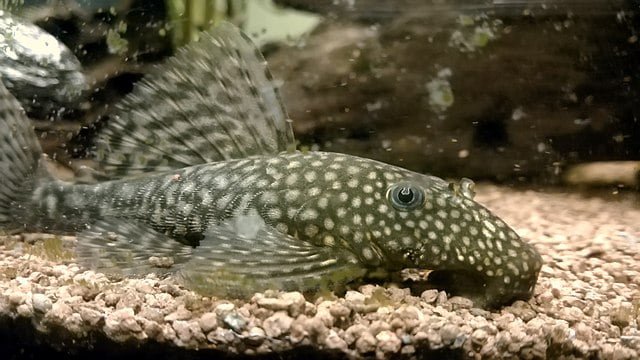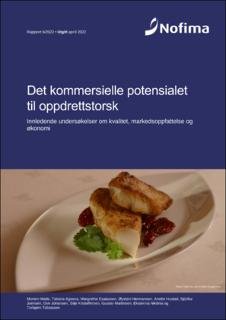Norway.- Øyvind J. Hansen has followed Norwegian farmed cod from when they were first spawned. As the fifth generation grows larger and larger as we speak, the researcher from Nofima has strong faith in the future of breeding and farming Norwegian cod.
“At least the biology indicates that we are now ready to take a step further and increase the volume of farmed cod”, says Øyvind J. Hansen.
Since their start in 2003, Nofima has worked on a National breeding programme for cod, with their headquarters based at Kraknes just outside Tromsø. Senior researcher Atle Mortensen has led the programme with a steady hand right up to the end of last year, and Øyvind J. Hansen has been part of his team since the beginning. Øyvind was the obvious choice when Mortensen wanted to hand over the leadership of the cod breeding programme to new blood. Since the start of the year, Øyvind has been responsible for professional research for both the National breeding programme for cod and the Centre for Marine Aquaculture – this is the site where Nofima conducts research regarding the breeding and farming of various marine species.
“I have been part of the programme’s development since production started in 2003. During this time, I have been responsible for the individual departments of live feed, broodstock, the hatchery and first-feeding. I feel confident in the role”, says the Nofima researcher.
The first few years consisted mostly of practical work. However, the cod breeding programme has also produced several scientific articles during the years.
“Several of the articles on topics such as egg quality, broodstock nutrition and the development of first-feed have been written in collaboration with industry partners”, says Øyvind Hansen.
Øyvind Hansen also receives help from a management team that includes the experienced researchers Velmurugu Puvanendran, Lill-Heidi Johansen and Anne Kettunen. In addition, the Centre for Marine Aquaculture has particularly skilled technicians who have also worked on the programme since its start.
Stay Always Informed
Join our communities to instantly receive the most important news, reports, and analysis from the aquaculture industry.
Stopped abruptly
Cod is important for the population along the Norwegian coast, and having access to a stable supply of cod has always been a dream. Therefore, the Norwegian authorities decided to establish a national breeding programme for cod in 2002. The aim was to breed farmed cod that have better growth characteristics than wild cod and that possess higher resistance to fish diseases.
There was great faith and high expectations regarding cod farming during the first years of business. At its peak, there were 15 cod hatcheries around the country. The harvest volume of farmed cod was 19,000 tonnes per year at its height. However, this positive development stopped abruptly in 2008 and commercial cod farming in Norway ended in 2014.
It could have stopped there.
However, Øyvind J. Hansen is both pleased and satisfied that those responsible in the Ministry of Trade, Industry and Fisheries decided that work on the breeding of cod should be continued.
Commitment to knowledge is never wrong. “I believe that such long-term commitments increase the speed of innovation and the likelihood of implementing new knowledge for industrial actors. This commitment has now produced a cod that is better suited for farming. Domesticating (turning into livestock) new species of fish takes time. Experience from other species shows that it takes up to 20 years to establish commercial farming of new species”, says the expert in cod breeding.
Today, the National breeding station for cod is the largest and longest-running breeding programme for marine fish in the world.
High level of survival after being moved to the sea
All is quiet in the “children’s room” – the first-feeding facility – at the cod breeding station at Kraknes outside Tromsø on this cold winter’s day in 2019. 296 tubs, each of which can contain 10,000 cod fry, are emptied, thoroughly cleaned and are now waiting to dry until the next generation of farmed cod moves in during the spring.
– “The drying is necessary and a preventive strategy in order to be absolutely sure that no infectious diseases can survive and spread from one generation to the next. This is how we ensure a predictable fry production. This is common practice in land-based aquaculture facilities for marine fry production”, explains the researcher.
However, the researchers have eliminated many types diseases and illnesses through the breeding work carried out. Deformity in cod that have grown up in captivity has been reduced to a minimum. And the mortality rate after moving the cod to the sea is around 16 percent – a little better compared to farmed salmon. However, there is still some way to go before one can be satisfied.
They started with “Generation 0”. Today, the fifth generation of farmed cod is swimming around the sea facility in Røsneshamn on Ringvassøy, just outside Kvaløy. The cod are held here until they are sexually mature. After 21 months in the sea, the farmed fish are around three kilos in weight and are ready to be slaughtered. This takes place at a time when there is a high demand on the market for the sought-after Norwegian cod.
A much better starting point
Each generation’s best individuals are transported back to the land facility at Kraknes to become the source of new generations.
Nofima has breeding stock from 600 families. Breeding stock from around 200 families are used for each generation.
“At first, we started a new generation every year. We have now reduced this somewhat and have produced five generations over 15 years”, says Øyvind J. Hansen.
The improvements that have been made over these 15 years, both in breeding and in production, allow cod farmers to have a far better starting point regarding their production than they had before. It provides increased production predictability and increased opportunities to achieve profitability within marine-based farming.
“And the price of farmed cod is on the rise. Today, those who choose to start farming cod commercially can do so with a completely different breeding stock compared to those who started in 2003. The fish have improved in all measurable parameters, and the fish from 2017 and 2018 have been well-received on the market”, says Øyvind J. Hansen.
Step by step
However, he does not see the farming of cod being a bonanza straight away. Despite very good breeding results, both in relation to illness and survival, there are no more than three or four actors who have been willing to invest in commercial cod farming again – and these are small pilot operations.
“But it looks like we’re about to take a step further. It is also important that the industry takes one step at a time. It takes time to learn how to farm a new species. It takes time to build the market. It doesn’t move fast, but it is heading in the right direction. It will be interesting to see the how it develops”, says Øyvind Hansen.
Unlike its wild cousins, the farmed cod is not fussy about food. In parallel with breeding research, the development of feed for marine species has also been ongoing.
– “In collaboration with the feed manufacturer Troms Fiskeindustri, we have made considerable progress in the development of first-feed for marine species. Testing takes place at our facilities and exports are sent to several countries in Europe”, explains the researcher.
High price
Nofima’s breeding research is nowhere near finished. The National breeding programme for cod will continue the process of making the Atlantic cod a robust “livestock”. However, it is planned that commercial actors are to take over the production and delivery of fry to cod farmers.
“We are able to deliver eggs from selected stock. It is the first phase that is difficult. When the fry is around 1 to 2 grams, it becomes a little cod that can be fed further in growth facilities”, says Øyvind J. Hansen.
In the meantime, he becomes a fish salesman once a year when the cod are harvested in the sea facilities.
“We ‘make’ a lot of fish, and only very few are used for the breeding programme. The rest are sold. We are getting high prices for some of the farmed cod right now. That is interesting”, says Nofima’s new ‘Codfather’.
Several species – many projects
Lumpfish breeding has already come a long way at Nofima’s breeding station. In the future, cod and lumpfish may be joined by several different marine species.
“Marine farming is currently undergoing a diversification process in Norway. It is important for both the export industry and the world’s demand for food from the sea”, says Øyvind J. Hansen.
In the years following the disappearance of cod farmers, Nofima continued to breed farmed cod. However, the specialist environment at the cod breeding station has also used their unique knowledge and infrastructure for other purposes. The Centre for Marine Aquaculture aims to use the knowledge gained from the breeding programme for cod to contribute to the knowledge of marine species in aquaculture and has concessions for several marine species.
“If the Centre for Marine Aquaculture is to work efficiently with several species, increased water capacity will provide better utilization of facility areas”, says Øyvind Hansen.
Lumpfish broodstock is already abundant at the breeding station he manages. The work to breed a healthy, robust and hungry louse-eater for use in salmon farming has been carried out in cooperation with industrial actors for many years – and is starting to produce good results.
“Knowledge, infrastructure and cod have also been used in the studies of ocean acidification and microplastics. This is knowledge that is very important for both industry and management. Exposure studies on cod, where one can follow effects through generations, can be easily carried out at the Centre for Marine Aquaculture”, says Øyvind Hansen.
The use of ultrasound to determine gender is a standard routine in the breeding programme for cod. This is to achieve the correct balance of the sexes in selected cod. Ultrasound helps to determine the gender of the fish without it having to be killed. Before Christmas, Hansen was therefore invited by researchers at the University of Tromsø to use ultrasound to determine the gender of polar cod. These fish would be used in a crude oil exposure experiment.
“The knowledge and infrastructure gained from the breeding programme for cod can be used for many different purposes. However, further genetic improvement of farmed cod is most important to us”, says the new manager, Øyvind J. Hansen.
Contact:
Øyvind Johannes Hansen
Scientist
Phone: +47 77 62 92 36
oyvind.j.hansen@nofima.no
Source: Nofima
Editor at the digital magazine AquaHoy. He holds a degree in Aquaculture Biology from the National University of Santa (UNS) and a Master’s degree in Science and Innovation Management from the Polytechnic University of Valencia, with postgraduate diplomas in Business Innovation and Innovation Management. He possesses extensive experience in the aquaculture and fisheries sector, having led the Fisheries Innovation Unit of the National Program for Innovation in Fisheries and Aquaculture (PNIPA). He has served as a senior consultant in technology watch, an innovation project formulator and advisor, and a lecturer at UNS. He is a member of the Peruvian College of Biologists and was recognized by the World Aquaculture Society (WAS) in 2016 for his contribution to aquaculture.




